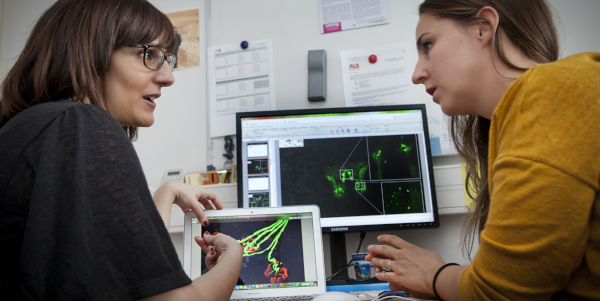 Interview with Maria-Grazia Biferi, Head of the BOND team (Motor-neurone disease [ALS & SMA] biotherapies team) and Aurore Besse, Preclinical Project Manager at the Institute of Myology.
Interview with Maria-Grazia Biferi, Head of the BOND team (Motor-neurone disease [ALS & SMA] biotherapies team) and Aurore Besse, Preclinical Project Manager at the Institute of Myology.
What are the origins of the project?
This project started as a doctoral thesis by Aurore Besse and, with great teamwork, resulted in publication last May in Molecular Therapy. This study follows on from the research work conducted by Martine Barkats’ team at the Institute of Myology, and prior to that at Généthon, since 2004. The goal of this research work was to develop innovative therapies for motor neurone diseases such as spinal muscular atrophy (SMA).
SMA is a neuromuscular disease, characterised by degeneration of the motor neurons and progressive muscle weakening, leading to paralysis and early death in the most serious cases. With an estimated incidence of 1 in 6,000–10,000 births, SMA is considered to be the main genetic cause of death in children under 2 years of age. SMA is caused by homozygous mutations or deletions in the telomeric copy of the Survival of Motor Neuron (SMN) gene, SMN1
How is this work positioned in the context of current therapeutic research in SMA, and what were the objectives of this research?
Currently, the main therapeutic approaches in SMA patients consists of increasing the level of SMN protein, in particular by gene therapy with Zolgensma® or by antisense oligonucleotide with nusinersen.
In the field of gene therapy, a significant therapeutic advance for SMA was made by Martine Barkats, following the discovery of the efficacy of the double-stranded adeno-associated virus serotype 9 (dsAAV9) vector in transferring genes into the central nervous system (CNS), following an intravenous injection (Barkats 2009; Duque et al. 2009). This discovery and the studies conducted by the B. Kaspar and J. Mendell groups in the United States made it possible to develop the first gene therapy medicine for SMA, Zolgensma® , which, as a reminder, obtained authorisation from the American Food and Drug Administration (FDA) in May 2019, and conditional authorisation from the European Medicines Agency (EMA) in May this year.
In our group, this AAV9 therapeutic strategy was used successfully in a severe SMA mouse model called SMNdelta7. Indeed, a single intravenous (IV) injection of dsAAV9 coding for the SMN1 gene, in newborn SMNdelta7 mice, resulted in a significant increase in their life expectancy (Dominguez et al. 2011).
As a continuation of this work, we have shown that the intra-cerebroventricular (ICV) injection of the dsAAV9 vector expressing the protein under the control of the ubiquitous promoter, phosphoglycerate kinase (AAV9-PGK-SMN), resulted in an increase in the mean survival of the SMNdelta7 mice compared to the IV injection. This therapeutic effect is related to a strong transduction of the motor neurons, but also of the peripheral tissues and organs, such as the skeletal muscles, the heart and the liver.
In order to determine the respective contribution of SMN expression in the neurons versus the peripheral organs on the survival of the SMNdelta7 mice, we designed a new dsAAV9 vector, expressing SMN under the control of the neuron-specific promoter, Synapsin (AAV9-SYN-SMN). We therefore compared the therapeutic effect of this new vector administered by ICV injection, to that of the AAV9-PGK-SMN administered by ICV or by IV injection, in SMNdelta7 mice.
What results were obtained?
Our data showed that the re-expression of the production of SMN in the neurons, including in the MNs, only provided a partial improvement in SMNdelta7 mice. This work also showed the importance of SMN re-expression in the peripheral organs, such as the skeletal muscles, the heart and the liver.
Interestingly, mice treated with AAV9-PGK-SMN by IV or ICV injection survived much longer than animals treated by ICV injection with AAV9-SYN-SMN, even though similar levels of SMN were found in CNS tissues when comparing animals treated by IV injection with AAV9-PGK-SMN and those treated by ICV injection with AAV9-SYN-SMN.
We also demonstrated that the ICV injection of AAV9-PGK-SMN was superior to the systemic administration of the same vector, allowing an expression of SMN at greater levels than those for healthy animals, in the CNS organs, and by re-establishing the expression of SMN in the peripheral organs.
What conclusions can be drawn and what benefits has it been possible to measure for these patients?
All these results show that the neuro-specific expression of SMN is necessary, but not sufficient to allow survival of the SMA mice, and therefore demonstrate the crucial role of SMN in the peripheral organs. Additional work is needed to understand the specific need for SMN in each organ and during the course of development. Studies combining the targeting properties of the AAV vectors with specific promoters could answer these questions. Research efforts in this field will one day help us develop tailored treatments specific to each patient with SMA.
